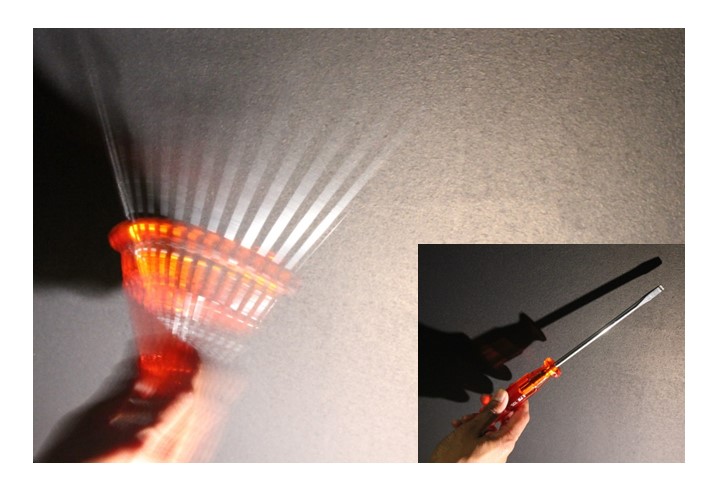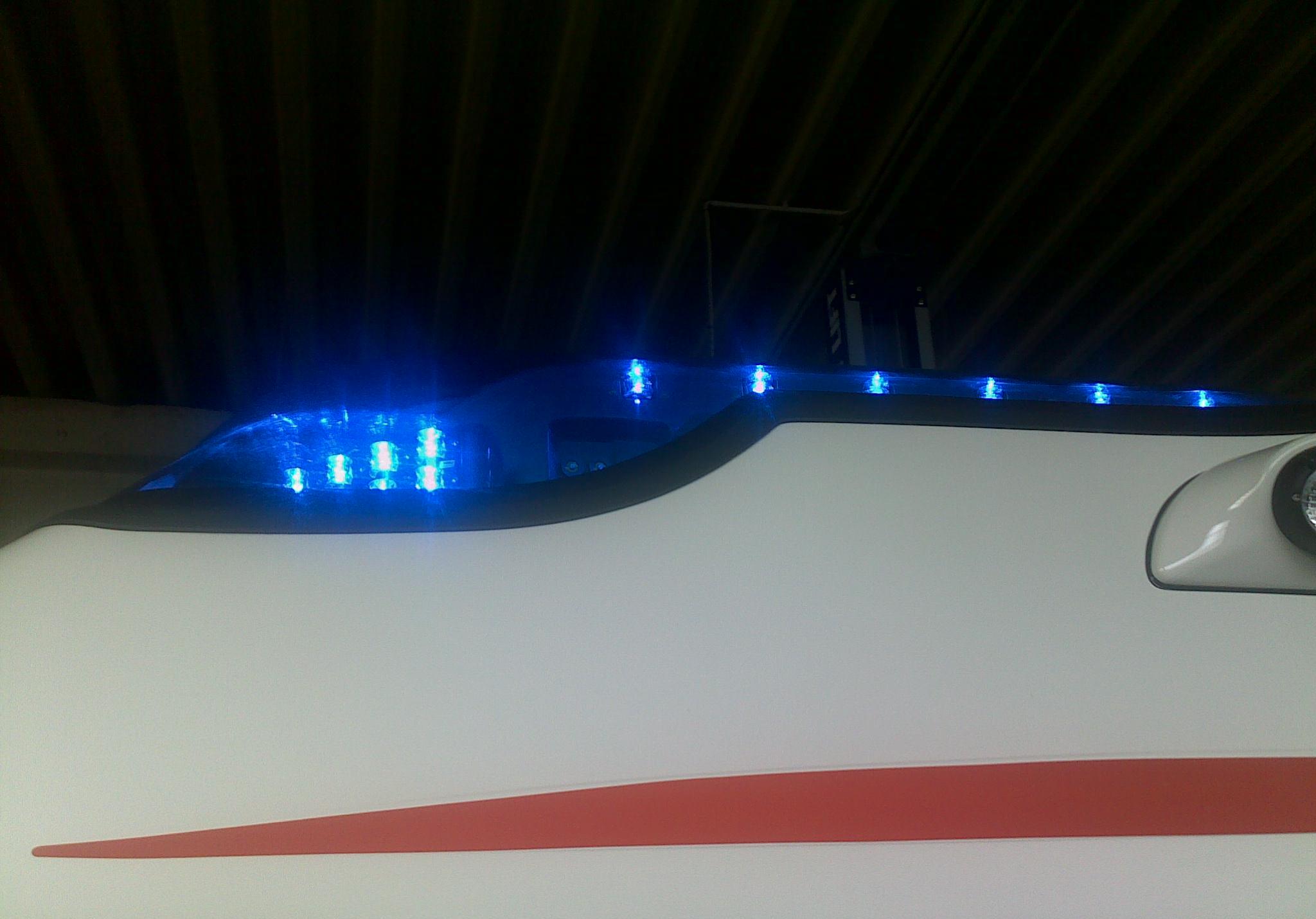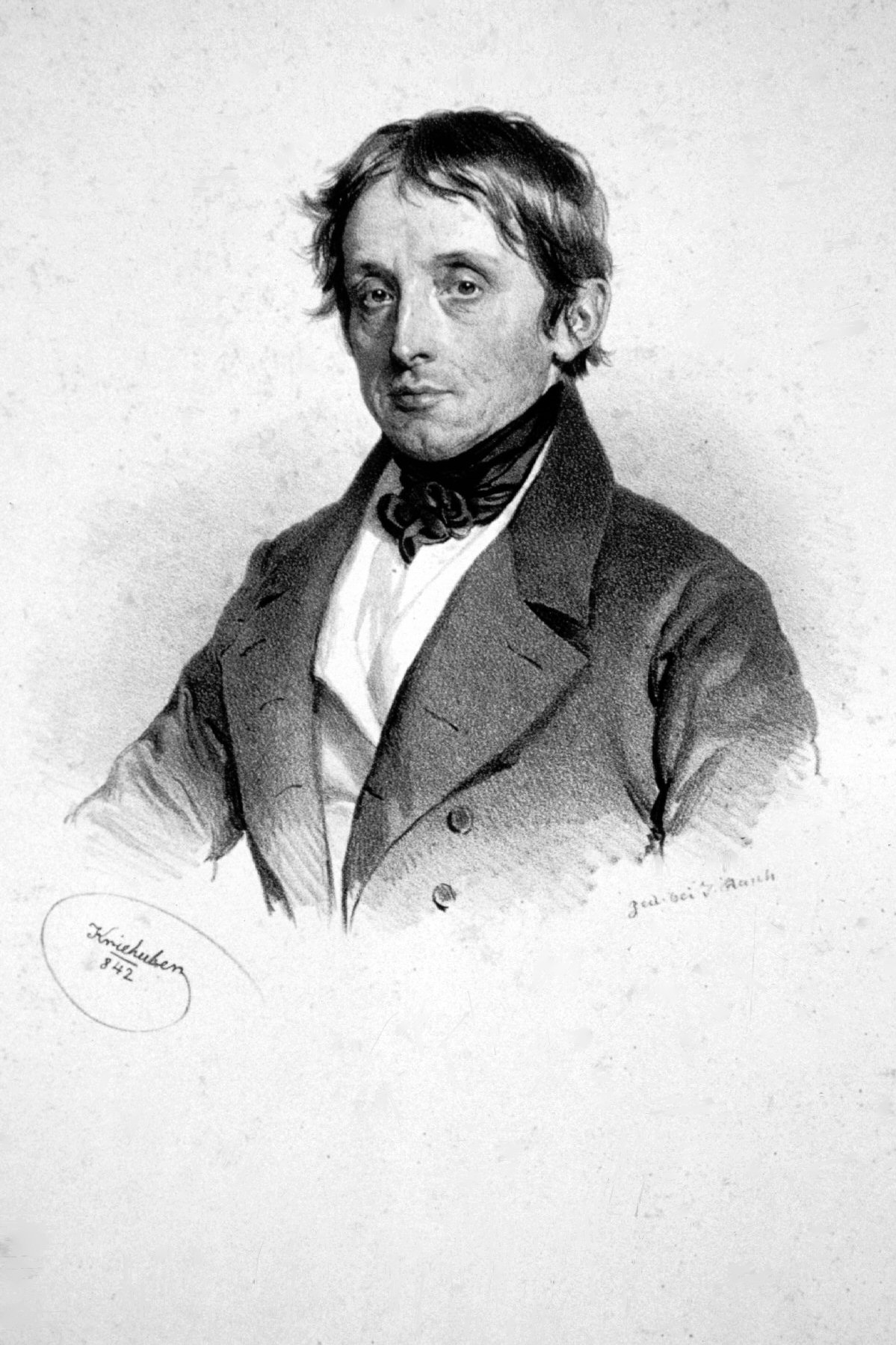|
Stroboscope
A stroboscope, also known as a strobe, is an instrument used to make a cyclically moving object appear to be slow-moving, or stationary. It consists of either a rotating disk with slots or holes or a lamp such as a flashtube which produces brief repetitive flashes of light. Usually, the rate of the stroboscope is adjustable to different frequencies. When a rotating or vibrating object is observed with the stroboscope at its vibration frequency (or a submultiple of it), it appears stationary. Thus stroboscopes are also used to measure frequency. The principle is used for the study of Rotation, rotating, reciprocating motion, reciprocating, oscillation, oscillating or vibration, vibrating objects. Machine parts and vibrating string are common examples. A stroboscope used to set the ignition timing of internal combustion engines is called a timing light. Mechanical In its simplest mechanical form, a stroboscope can be a rotating cylinder (or bowl with a raised edge) with ev ... [...More Info...] [...Related Items...] OR: [Wikipedia] [Google] [Baidu] |
Harold Eugene Edgerton
Harold Eugene "Doc" Edgerton (April 6, 1903 – January 4, 1990), also known as Papa Flash, was an American scientist and researcher, a professor of electrical engineering at the Massachusetts Institute of Technology. He is largely credited with transforming the stroboscope from an obscure laboratory instrument into a common device. He also was deeply involved with the development of sonar and deep-sea photography, and his equipment was used in collaboration with Jacques Cousteau in searches for shipwrecks and even the Loch Ness Monster. Biography Early years Edgerton was born in Fremont, Nebraska, on April 6, 1903, the son of Mary Nettie Coe and Frank Eugene Edgerton, a descendant of Samuel Edgerton, the son of Richard Edgerton, one of the founders of Norwich, Connecticut, and Alice Ripley, a great-granddaughter of Governor William Bradford (1590–1657) of the Plymouth Colony and a passenger on the Mayflower. His father was a lawyer, journalist, author and orator and served as ... [...More Info...] [...Related Items...] OR: [Wikipedia] [Google] [Baidu] |
Stroboscopic Effect
The stroboscopic effect is a visual optical phenomenon, phenomenon caused by aliasing that occurs when continuous rotational or other cyclic motion is represented by a series of short or instantaneous samples (as opposed to a continuous view) at a sampling rate close to the period of the motion. It accounts for the "wagon-wheel effect", so-called because in video, spoked wheels (such as on horse-drawn wagons) sometimes appear to be turning backwards. A strobe fountain, a stream of water droplets falling at regular intervals lit with a strobe light, is an example of the stroboscopic effect being applied to a cyclic motion that is not rotational. When viewed under normal light, this is a normal water fountain. When viewed under a strobe light with its frequency tuned to the rate at which the droplets fall, the droplets appear to be suspended in mid-air. Adjusting the strobe frequency can make the droplets seemingly move slowly up or down. Depending upon the frequency of illuminatio ... [...More Info...] [...Related Items...] OR: [Wikipedia] [Google] [Baidu] |
Strobe 2
A strobe light or stroboscopic lamp, commonly called a strobe, is a device used to produce regular flashes of light. It is one of a number of devices that can be used as a stroboscope. The word originated from the Ancient Greek ('), meaning "act of whirling". A typical commercial strobe light has a flash energy in the region of 10 to 150 joules, and discharge times as short as a few milliseconds, often resulting in a flash power of several kilowatts. Larger strobe lights can be used in “continuous” mode, producing extremely intense illumination. The light source is commonly a xenon flash lamp, or ''flashtube'', which has a complex spectrum and a color temperature of approximately 5,600 kelvins. To obtain colored light, colored gels may be used. Scientific explanation of flashtubes Strobe lights usually use flashtubes with energy supplied from a capacitor, an energy storage device much like a battery, but capable of charging and releasing energy much faster. In a c ... [...More Info...] [...Related Items...] OR: [Wikipedia] [Google] [Baidu] |
Strobe Light
A strobe light or stroboscopic lamp, commonly called a strobe, is a device used to produce regular flashes of light. It is one of a number of devices that can be used as a stroboscope. The word originated from the Ancient Greek ('), meaning "act of whirling". A typical commercial strobe light has a flash energy in the region of 10 to 150 joules, and discharge times as short as a few milliseconds, often resulting in a flash power of several kilowatts. Larger strobe lights can be used in “continuous” mode, producing extremely intense illumination. The light source is commonly a xenon flash lamp, or ''flashtube'', which has a complex spectrum and a color temperature of approximately 5,600 kelvins. To obtain colored light, colored gels may be used. Scientific explanation of flashtubes Strobe lights usually use flashtubes with energy supplied from a capacitor, an energy storage device much like a battery, but capable of charging and releasing energy much faster. In ... [...More Info...] [...Related Items...] OR: [Wikipedia] [Google] [Baidu] |
Neon Lamp
A neon lamp (also neon glow lamp) is a miniature gas-discharge lamp. The lamp typically consists of a small glass capsule that contains a mixture of neon and other gases at a low pressure and two electrodes (an anode and a cathode). When sufficient voltage is applied and sufficient current is supplied between the electrodes, the lamp produces an orange glow discharge. The glowing portion in the lamp is a thin region near the cathode; the larger and much longer neon signs are also glow discharges, but they use the positive column which is not present in the ordinary neon lamp. Neon glow lamps were widely used as indicator lamps in the displays of electronic instruments and appliances. They are still sometimes used for their electrical simplicity in high-voltage circuits. History Neon was discovered in 1898 by William Ramsay and Morris Travers. The characteristic, brilliant red color that is emitted by gaseous neon when excited electrically was noted immediately; Travers ... [...More Info...] [...Related Items...] OR: [Wikipedia] [Google] [Baidu] |
Frequency
Frequency is the number of occurrences of a repeating event per unit of time. Frequency is an important parameter used in science and engineering to specify the rate of oscillatory and vibratory phenomena, such as mechanical vibrations, audio signals (sound), radio waves, and light. The interval of time between events is called the period. It is the reciprocal of the frequency. For example, if a heart beats at a frequency of 120 times per minute (2 hertz), its period is one half of a second. Special definitions of frequency are used in certain contexts, such as the angular frequency in rotational or cyclical properties, when the rate of angular progress is measured. Spatial frequency is defined for properties that vary or cccur repeatedly in geometry or space. The unit of measurement of frequency in the International System of Units (SI) is the hertz, having the symbol Hz. Definitions and units For cyclical phenomena such as oscillations, waves, or for examp ... [...More Info...] [...Related Items...] OR: [Wikipedia] [Google] [Baidu] |
Phenakistoscope
The phenakistiscope (also known by the spellings phénakisticope or phenakistoscope) was the first widespread animation device that created a fluid illusion of motion. Dubbed and ('stroboscopic discs') by its inventors, it has been known under many other names until the French product name became common (with alternative spellings). The phenakistiscope is regarded as one of the first forms of moving media entertainment that paved the way for the future motion picture and film industry. Similar to a GIF animation, it can only show a short continuous loop. Etymology and spelling When it was introduced in the French newspaper in June 1833, the term 'phénakisticope' was explained to be from the root Greek word ''phenakistikos'' (or rather from φενακίζειν ''phenakizein''), meaning "deceiving" or "cheating", and ὄψ ''óps'', meaning "eye" or "face", so it was probably intended loosely as 'optical deception' or 'optical illusion'. The term phénakisticope was firs ... [...More Info...] [...Related Items...] OR: [Wikipedia] [Google] [Baidu] |
Joseph Plateau
Joseph Antoine Ferdinand Plateau (; 14 October 1801 – 15 September 1883) was a Belgian physicist and mathematician. He was one of the first people to demonstrate the illusion of a moving image. To do this, he used counterrotating disks with repeating drawn images in small increments of motion on one and regularly spaced slits in the other. He called this device of 1832 the phenakistiscope. Biography Plateau was born on 14 October 1801, in Brussels. His father, Antoine Plateau ( fr) born in Tournai, was a talented flower painter. At the age of six, the younger Plateau already could read, making him a child prodigy in those times. While attending primary school, he was particularly impressed by a lesson of physics; enchanted by the experiments he observed, he vowed to discover their secrets someday. Plateau spent his school holidays in Marche-les-Dames, with his uncle and his family; his cousin and playfellow was Auguste Payen, who later became an architect and the principal ... [...More Info...] [...Related Items...] OR: [Wikipedia] [Google] [Baidu] |
Timing Light
A timing light is a stroboscope used to dynamically set the ignition timing of an Otto cycle or similar internal combustion engine equipped with a distributor. Modern electronically controlled passenger vehicle engines require use of a scan tool to display ignition timing. The timing light is connected to the ignition circuit and used to illuminate the timing marks on the engine's crankshaft pulley or flywheel, with the engine running. The apparent position of the marks, frozen by the stroboscopic effect, indicates the current timing of the spark in relation to piston position. A reference pointer is attached to the flywheel housing or other fixed point, and an engraved scale gives the offset between the spark time and the top dead centre position of the piston in the cylinder. The distributor can be rotated slightly until the reference pointer aligns with the specified point on the timing scale. Fuel-injected engines, or engines with microprocessor controls may require specia ... [...More Info...] [...Related Items...] OR: [Wikipedia] [Google] [Baidu] |
Film
A film, also known as a movie or motion picture, is a work of visual art that simulates experiences and otherwise communicates ideas, stories, perceptions, emotions, or atmosphere through the use of moving images that are generally, since the 1930s, synchronized with sound and (less commonly) other sensory stimulations. Etymology and alternative terms The name "film" originally referred to the thin layer of photochemical emulsion on the celluloid strip that used to be the actual medium for recording and displaying motion pictures. Many other terms exist for an individual motion-picture, including "picture", "picture show", "moving picture", "photoplay", and "flick". The most common term in the United States is "movie", while in Europe, "film" is preferred. Archaic terms include "animated pictures" and "animated photography". "Flick" is, in general a slang term, first recorded in 1926. It originates in the verb flicker, owing to the flickering appearance of early films ... [...More Info...] [...Related Items...] OR: [Wikipedia] [Google] [Baidu] |
Simon Ritter Von Stampfer
Simon Ritter von Stampfer (26 October 1792 (according to other sources 1790)), in Windisch-Mattrai, Archbishopric of Salzburg, today called Matrei in Osttirol, Tyrol (state), Tyrol – 10 November 1864 in Vienna) was an Austrian mathematician, Surveying, surveyor and inventor. His most famous invention is that of the stroboscopic disk which has a claim to be the first device to show moving images. Almost simultaneously, a similar device was developed in Belgium (the Phenakistoscope, phenakistiscope). Life Youth and education Simon Ritter von Stampfer was born in Matrei in Osttirol, and was the first son of Bartlmä Stampfer, a weaving, weaver. From 1801 he attended the local school and in 1804 and moved to the Franciscan Gymnasium in Lienz, where he studied until 1807. From there he went to the Lyceum in Salzburg, to study philosophy, however he was not assessed. In 1814 in Munich, he passed the state examination and applied there as a teacher. He chose, however, to s ... [...More Info...] [...Related Items...] OR: [Wikipedia] [Google] [Baidu] |
Austria
Austria, formally the Republic of Austria, is a landlocked country in Central Europe, lying in the Eastern Alps. It is a federation of nine Federal states of Austria, states, of which the capital Vienna is the List of largest cities in Austria, most populous city and state. Austria is bordered by Germany to the northwest, the Czech Republic to the north, Slovakia to the northeast, Hungary to the east, Slovenia and Italy to the south, and Switzerland and Liechtenstein to the west. The country occupies an area of and has Austrians, a population of around 9 million. The area of today's Austria has been inhabited since at least the Paleolithic, Paleolithic period. Around 400 BC, it was inhabited by the Celts and then annexed by the Roman Empire, Romans in the late 1st century BC. Christianization in the region began in the 4th and 5th centuries, during the late Western Roman Empire, Roman period, followed by the arrival of numerous Germanic tribes during the Migration Period. A ... [...More Info...] [...Related Items...] OR: [Wikipedia] [Google] [Baidu] |








